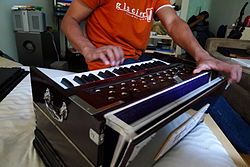A harmonium is a free-standing keyboard instrument similar to a reed organ. Sound is produced by air being blown through sets of free reeds, resulting in a sound similar to that of an accordion. The air is usually supplied by bellows operated by foot, hand, or knees.
In North America, the most common pedal-pumped free-reed keyboard instrument is known as the American Reed Organ, (or parlor organ, pump organ, cabinet organ, cottage organ, etc.) and along with the earlier melodeon, is operated by a suction bellows where air is sucked through the reeds to produce the sound. A reed organ with a pressure bellows, that pushes the air through the reeds, is referred to as a harmonium.
In much of Europe, the term "harmonium" is used to describe all pedal-pumped keyboard free-reed instruments, making no distinction whether it has a pressure or suction bellows.

